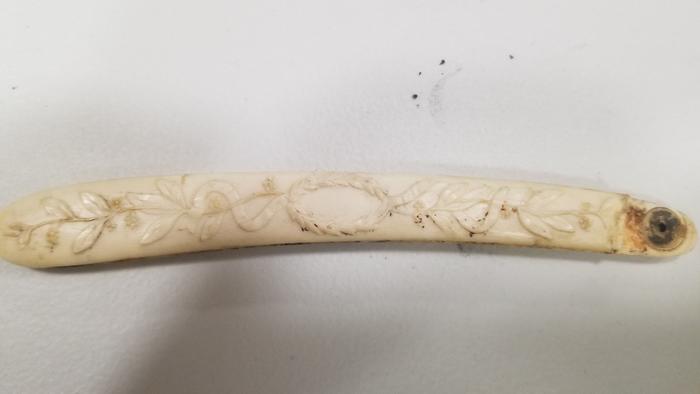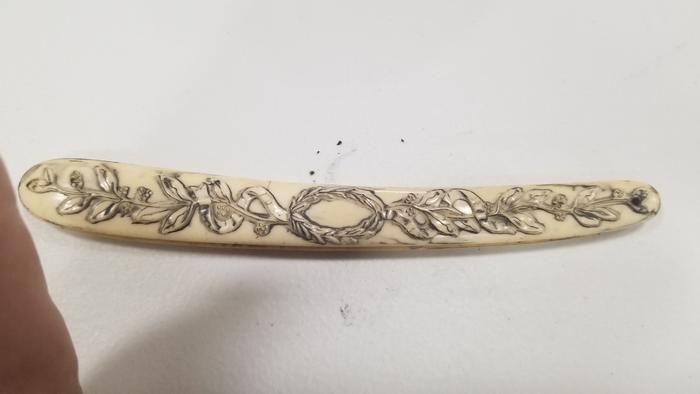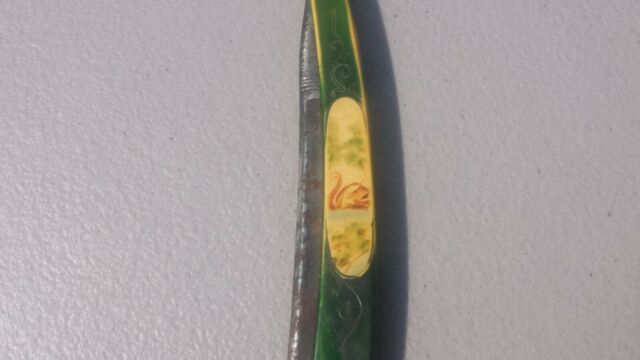Results 1 to 10 of 15
-
01-09-2020, 04:20 AM #1Hones & Honing




- Join Date
- May 2005
- Location
- Saint Paul, Minnesota, United States
- Posts
- 8,023
- Blog Entries
- 1
Thanked: 2209 A question about custom scales ....
A question about custom scales ....
Hello all,
Today i have been working on some old decrepit razors trying to salvage what i can.
This is a scale that i have a question about.

This is a design that many of us have seen before. But ..... i took it to the buffer with some black buffing compound and the result was surprising .....

The buffing compound obviously became embedded in the pattern but what struck me was the level of detail that became apparent.
This reminded me of the multi color scales we have seen from makers like Tadross.
So, does anyone have a suggestion on how i can make the black color permanent?Last edited by randydance062449; 01-09-2020 at 04:23 AM.
Randolph Tuttle, a SRP Mentor for residents of Minnesota & western Wisconsin
-
01-09-2020, 04:27 AM #2

Depending on the material you could possibly use a dye or paint; rub on and wipe off, similar to the antiquing or weathering process used in other crafts.
-
01-09-2020, 04:34 AM #3Hones & Honing




- Join Date
- May 2005
- Location
- Saint Paul, Minnesota, United States
- Posts
- 8,023
- Blog Entries
- 1
Thanked: 2209
From the world of gun engraving I read one persons method of making his blacking permanent and that was to take some Testors black enamel paint and combine it with equal parts of dry powder coating, mix, then thin to the desired consistency with paint thinner apply to your workpiece and wipe off the excess. Then bake in an oven at some temp/time combo.
https://www.facebook.com/sandi.sturg...5676845570459/Last edited by randydance062449; 01-09-2020 at 04:38 AM.
Randolph Tuttle, a SRP Mentor for residents of Minnesota & western Wisconsin
-
01-09-2020, 04:36 AM #4Hones & Honing




- Join Date
- May 2005
- Location
- Saint Paul, Minnesota, United States
- Posts
- 8,023
- Blog Entries
- 1
Thanked: 2209
-
01-09-2020, 04:44 AM #5
-
01-09-2020, 04:52 AM #6

I'd say enamel paint would probably be your best bet. It seems it's a common method for model making. Using an enamel wash and then letting it dry for a 15-45 minutes and removing the excess with a cotton ball or qtip and some paint thinner.
Last edited by thehattr; 01-09-2020 at 05:03 AM.
-
The Following User Says Thank You to thehattr For This Useful Post:
randydance062449 (01-09-2020)
-
01-09-2020, 05:40 AM #7At this point in time...




- Join Date
- Jun 2007
- Location
- North Idaho Redoubt
- Posts
- 27,206
- Blog Entries
- 1
Thanked: 13250
Before you wreck the scales
You cannot use any Naptha, Toluene, Acetone type solutions on Celluloid it will destroy them REALLY fast
Basically rule of thumb, "If you sniff it and you jerk your nose away Keep it off the scales until you test it""No amount of money spent on a Stone can ever replace the value of the time it takes learning to use it properly"
Very Respectfully - Glen
Proprietor - GemStar Custom Razors Honing/Restores/Regrinds Website
-
The Following User Says Thank You to gssixgun For This Useful Post:
randydance062449 (01-09-2020)
-
01-09-2020, 05:55 AM #8Hones & Honing




- Join Date
- May 2005
- Location
- Saint Paul, Minnesota, United States
- Posts
- 8,023
- Blog Entries
- 1
Thanked: 2209
Well, I did not think these were celluloid so I tried naptha and acetone on different areas.
Boy was I wrong!
The acetone started melting the scales immediately! Randolph Tuttle, a SRP Mentor for residents of Minnesota & western Wisconsin
Randolph Tuttle, a SRP Mentor for residents of Minnesota & western Wisconsin
-
01-09-2020, 05:57 AM #9Hones & Honing




- Join Date
- May 2005
- Location
- Saint Paul, Minnesota, United States
- Posts
- 8,023
- Blog Entries
- 1
Thanked: 2209
I wonder how Antoni Tadross made those multicolored scales? Hmmmm .....

Last edited by randydance062449; 01-09-2020 at 06:00 AM.
Randolph Tuttle, a SRP Mentor for residents of Minnesota & western Wisconsin
-
01-09-2020, 06:02 AM #10

Yes any chemical and plastic is a no no

What sprung to my modest mind was Rub n Buff.. Of the top of my head.


 46Likes
46Likes LinkBack URL
LinkBack URL About LinkBacks
About LinkBacks






 Reply With Quote
Reply With Quote
